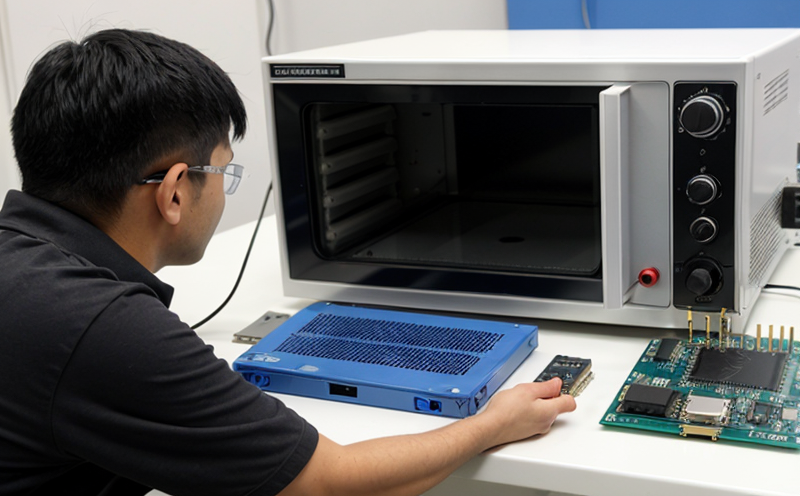ASTM F1249 Moisture Permeability Testing for Semiconductor Packaging
The ASTM F1249 standard is a critical tool used to assess the moisture permeability of semiconductor packages. This test ensures that semiconductor devices are protected against environmental conditions, particularly moisture ingress which can lead to short circuits and other failures. The standard is widely recognized in industries where reliability and durability are paramount.
The testing process involves subjecting the package to controlled humidity environments to observe the rate at which moisture penetrates through the packaging material. This helps manufacturers identify any weaknesses in their design that could compromise the integrity of the semiconductor device. Understanding this metric is crucial for ensuring long-term performance and reliability, especially in harsh environmental conditions.
The test procedures are meticulously detailed within ASTM F1249, providing a standardized approach to evaluate the moisture resistance of various materials used in semiconductor packaging. Compliance with this standard ensures that products meet industry requirements, enhancing trust among customers and stakeholders. This is particularly important for sectors like aerospace, automotive, and consumer electronics where reliability is non-negotiable.
When selecting an appropriate material for semiconductor packaging, it’s essential to consider the moisture resistance properties of the chosen materials. ASTM F1249 provides a reliable method to assess these properties, ensuring that manufacturers can make informed decisions about their product design. This not only enhances the overall quality but also helps in meeting regulatory compliance requirements.
The test results provide valuable insights into potential failure modes due to moisture ingress. By identifying these issues early on, manufacturers can implement corrective measures and improve the robustness of their products. This proactive approach is particularly beneficial for R&D teams as they refine their designs based on real-world testing data rather than relying solely on theoretical models.
In summary, ASTM F1249 moisture permeability testing is an indispensable tool in ensuring the reliability and durability of semiconductor packages. It plays a crucial role in protecting sensitive components from environmental hazards and maintaining product integrity over time. By adhering to this standard, manufacturers can enhance their reputation for quality and compliance with industry best practices.
Why It Matters
The importance of ASTM F1249 moisture permeability testing cannot be overstated in the semiconductor packaging sector. Moisture ingress is one of the leading causes of failure in electronic devices, especially those exposed to humid environments or subjected to temperature cycling conditions.
- It ensures that the packaged components are protected against environmental factors like humidity, which can lead to corrosion and short circuits.
- Compliance with ASTM F1249 helps manufacturers meet industry standards and regulatory requirements, thereby enhancing product quality and reliability.
- The test results provide critical data for R&D teams to refine their designs and improve the robustness of semiconductor packages. This is particularly beneficial in ensuring long-term performance and durability.
By implementing ASTM F1249 moisture permeability testing, manufacturers can significantly reduce warranty claims and product returns due to premature failures. Additionally, it fosters trust among customers by demonstrating a commitment to quality and reliability.
Scope and Methodology
| Test Parameter | Description |
|---|---|
| Humidity Exposure | The specimen is exposed to controlled humidity environments for a specified duration. |
| Weighing Procedure | The weight of the specimen before and after exposure is recorded to determine the amount of moisture absorbed. |
| Environmental Conditions | The test can be conducted under various temperature and humidity conditions as specified in ASTM F1249. |
| Data Analysis | The rate of moisture absorption is calculated based on the weight change data. |
The scope of ASTM F1249 includes evaluating the moisture resistance properties of different materials used in semiconductor packaging. The methodology involves subjecting the specimen to controlled humidity conditions for a specified period, followed by weighing the specimen before and after exposure. The rate of moisture absorption is then calculated based on these measurements.
The test can be conducted under various environmental conditions as per ASTM F1249 specifications. This allows manufacturers to assess how different materials perform in real-world scenarios, ensuring that the chosen materials are suitable for their intended applications.
Why Choose This Test
- The test provides a standardized approach to evaluate moisture resistance properties of semiconductor packages, ensuring consistency and comparability across different manufacturers.
- ASTM F1249 is widely recognized in the industry, making it easier for companies to meet regulatory compliance requirements.
- The results offer valuable insights into potential failure modes due to moisture ingress, allowing manufacturers to implement corrective measures early on.
By choosing ASTM F1249 moisture permeability testing, manufacturers can enhance the reliability and durability of their products. This is especially important for sectors like aerospace, automotive, and consumer electronics where performance under harsh conditions is crucial.
The test also provides a reliable method to assess different materials used in semiconductor packaging, helping manufacturers make informed decisions about their product design. This ensures that the chosen materials are suitable for their intended applications and can withstand environmental challenges effectively.





